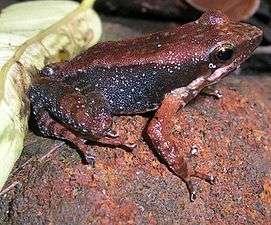Micrixalus fuscus
Micrixalus fuscus (dusky torrent frog or brown tropical frog) is a species of small frog found in dense forested hill streams in the Western Ghats of India.[2][3] M. herrei was formerly synonymized[4] within this species.[3]
| Micrixalus fuscus | |
|---|---|
 | |
| Scientific classification | |
| Kingdom: | Animalia |
| Phylum: | Chordata |
| Class: | Amphibia |
| Order: | Anura |
| Family: | Micrixalidae |
| Genus: | Micrixalus |
| Species: | M. fuscus |
| Binomial name | |
| Micrixalus fuscus (Boulenger, 1882) | |
| Synonyms | |
|
Ixalus fuscus Boulenger, 1882 | |
Description
Males measure 27.9–28.8 mm (1.10–1.13 in) and females 30.0–33.1 mm (1.18–1.30 in) in snout–vent length.[3] Male Micrixalus fuscus have a single vocal sac, a white patch on the lower jaw, and a prominent nuptial pad on the first finger. Characteristic for the genus, they display the "foot-flagging" behavior, where males tap their hindfeet and extend it, then stretching it out and shaking the foot at prospective mates and rival males. Male-male combats also involve kicking.[3]
Description from G. A. Boulenger's (1890) "Fauna of British India":[5]
- Snout pointed, prominent, generally longer than the orbital diameter; canthus rostralis angular: loreal region flat, vertical; nostril halfway between the eye and the tip of the snout; interorbital space as broad as the upper eyelid; tympanum small, indistinct. Toes nearly entirely webbed; disks moderate; subarticular tubercles small; a small inner metatarsal tubercle. The tibio-tarsal articulation reaches between the eye and the tip of the snout. Skin smooth above and beneath; a narrow glandular lateral fold; a fold from the eye to the shoulder. Brown or pinkish above; sides of head and body generally darker; limbs with dark cross bands; hinder side of thighs dark brown, with a more or less accentuated light median stripe; whitish beneath, marbled with brown. Male with two internal vocal sacs, the openings of which are very small. From snout to vent 1.2 inches.
Habitat
The natural habitats of this species are fast-flowing streams covered by forest canopy. It is relatively abundant where it has been found.[3]
References
- S.D. Biju, Sushil Dutta, Karthikeyan Vasudevan, S.P. Vijayakumar, M.S. Ravichandran (2004). "Micrixalus fuscus". IUCN Red List of Threatened Species. 2004: e.T58378A11762825. doi:10.2305/IUCN.UK.2004.RLTS.T58378A11762825.en.CS1 maint: uses authors parameter (link)
- Frost, Darrel R. (2016). "Micrixalus fuscus (Boulenger, 1882)". Amphibian Species of the World: an Online Reference. Version 6.0. American Museum of Natural History. Retrieved 2 June 2016.
- Biju, S. D.; Sonali Garg; K. V. Gururaja; Yogesh Shouche; Sandeep A. Walujkar (2014). "DNA barcoding reveals unprecedented diversity in Dancing Frogs of India (Micrixalidae, Micrixalus): a taxonomic revision with description of 14 new species". Ceylon Journal of Science (Biological Sciences). 43 (1): 37–123. doi:10.4038/cjsbs.v43i1.6850. (M. fuscus: p. 67)
- Inger, R. F.; H. B. Shaffer; M. Koshy; R. Bakde (1984). "A report on a collection of amphibians and reptiles from the Ponmudi, Kerala, South India". Journal of the Bombay Natural History Society. 81: 406–427.
- Boulenger, G. A. (1890). Fauna of British India, including Ceylon and Burma. Reptilia and Batrachia. London: Taylor and Francis. p. 570.
| Wikimedia Commons has media related to Micrixalus fuscus. |
